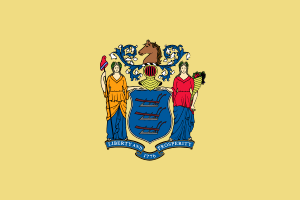Cortlandt Skinner
| Courtlandt Skinner | |
|---|---|
| Speaker of the New Jersey General Assembly | |
|
In office 1765–1770 | |
| Governor | William Franklin |
| Preceded by | Robert Ogden |
| Succeeded by | Stephen Crane |
| Speaker of the New Jersey General Assembly | |
|
In office 1765–1770 | |
| Governor | William Franklin |
| Preceded by | Stephen Crane |
| Succeeded by | John Hart |
| Member of the New Jersey General Assembly from the City of Perth Amboy district | |
|
In office 1763–1775 Serving with John Johnston, John L. Johnston, John Coombs | |
| 7th New Jersey Attorney General | |
|
In office 1754–1776 | |
| Governor | Jonathan Belcher, Sir Francis Bernard, Thomas Boone, Josiah Hardy, William Franklin |
| Preceded by | Joseph Warrell |
| Succeeded by | William Paterson |
| Personal details | |
| Born |
December 16, 1727 Perth Amboy, Middlesex County, Province of New Jersey, British North America, British Empire |
| Died |
15 March 1799 (aged 71) Bristol, England |
| Resting place | St. Augustine's Churchyard, Bristol |
| Nationality | British |
| Spouse(s) | Elizabeth Kearney |
| Relations | Stephanus Van Cortlandt (grandfather), Philip Kearney (father-in-law) |
| Children | Cortlandt Skinner Jr., Maria Skinner, Sir George Nugent, 1st Baronet (son-in-law) |
| Parents | William Skinner and and Elizabeth Cortland (Van Cortlandt) |
| Occupation | attorney general, attorney, colonial militia officer |
Cortlandt Skinner (December 16, 1727 – March 15, 1799) was the last Royal Attorney General of New Jersey and a Brigadier General, in the British, Loyalist force, the "New Jersey Volunteers" also, known as "Skinner's Greens", during the American Revolutionary War.
Early life
Cortlandt Skinner was born December 16, 1727, to a wealthy family, in Perth Amboy, Middlesex County, Province of New Jersey, British North America, British Empire, the eldest son of the Reverend William Skinner. and Elizabeth Cortland (the daughter of Stephanus Van Cortlandt, the first native born mayor of New York). Skinner was of English, Dutch, and possibly, Scottish ancestry. There was a firm family tradition, that William Skinner, later the Rector of St. Peter's Church in Perth Amboy, had participated in one of the Jacobite risings, and was related to the chiefs of the Clan Gregor - changing his name from MacGregor to avoid the persecution inflicted upon all those of that name.
Family
In 1751, Cortlandt Skinner married Elizabeth Kearney, the daughter of Philip Kearney, of Perth Amboy, New Jersey. They had manys children, including Cortlandt Skinner Jr. and Maria Skinner, who married Sir George Nugent, 1st Baronet also, known as General George Nugent MP and later Field-Marshal George Nugent.
Legal and political career in the coming American Revolution
Cortlandt Skinner studied law at Newark while clerking for David Ogden, a member of the governor's council, and then began practising at Perth Amboy. At the age of twenty-seven, he was appointed Attorney General of New Jersey in 1754 and also acted as speaker of the provincial Assembly between 1765 and 1770 and between 1772 and 1776. Sources differ as to his conduct as Attorney-General of New Jersey, but his general reputation was one of integrity and ability.
Military career in American Revolutionary War
Cortlandt Skinner was one of the three current and past speakers, of the Province of New Jersey colonial assemblies, who actively opposed American independence. At the outbreak, of the hostilities, in the American colonies, Cortlandt Skinner was offered, by the Patriot rebels, the pick of all civilian and military posts. In January, 1776, Skinner fled, after having received an intercepted letter, authorizing his arrest, by the Rebels.
As a prominent, New Jersey Loyalist, Cortlandt Skinner accepted service and a commission, on September 4, 1776, as a brigadier general, under the British Crown and was authorized to raise a Provincial corps, known as the New Jersey Volunteers and "Skinner's Greens". Three battalions were authorized, to consist of 2,500 soldiers. In the first months, of trying to increase enlistments, the corps could only raise 1,000 men, but eventually, Skinner's Greens increased their ranks to 2,000 soldiers. The New Jersey Volunteers mercilessly harassed, their Loyalist and Patriot rebel opponents, throughout the war, in the Province of New York, from the defensive outposts, of Long Island, to Staten Island.
By the end of war, in 1783, Brigadier General Skinner was one of the three, highest ranking, Loyalist officers, in the British Army.
Exile to England, later life, and death
His wife and family embarked for England in the summer of 1783, in the Le Solitaire, and were forced into Halifax by stress of weather. He himself followed after the evacuation of New York City. His claim to compensation for his losses as a Loyalist was difficult to adjust, and caused the Commissioners much labour ; but an allowance was finally made; and he also received the half-pay of a Brigadier-General during his life. He died at Bristol, England, in 1799, aged seventy-one. He is buried in St. Augustine's Church, Bristol.
References
This entry incorporates text from Lorenzo Sabine's Biographical Sketches of Loyalists of the American Revolution (1843), a publication now in the public domain.
- Susan Burgess Shenstone, So Obstinately Loyal: James Moody, 1744-1809 (McGill-Queen's University Press, 2000)
- W.D.Hoyle, The Macgregor Family, in volume 8 of The Scottish Antiquary, or Northern Notes and Queries (Edinburgh, 1894)
- A.G.M. MacGregor, History of the Clan Gregor, Volume II, (William Brown, 26 Princes Street, Edinburgh, 1901)
